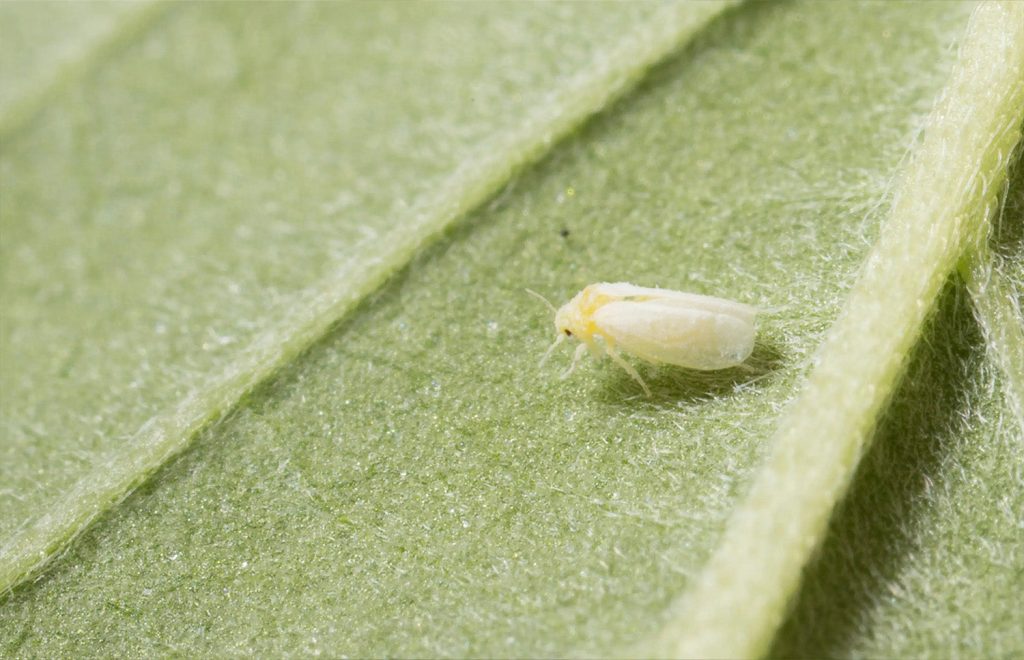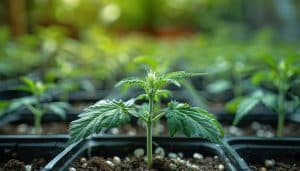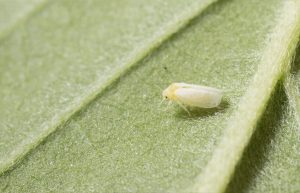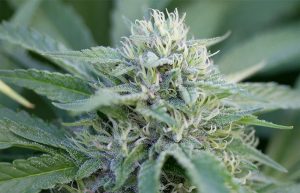- There are many harmful natural plagues that can affect the cannabis plant, such as fungal diseases, plant viruses and even harmful insects.
- Having recently dealt with the first two subjects in depth, we will now focus on the different types of insect pests which are capable of attacking our cannabis crops, and causing the partial or total loss of the harvest.
- In this article, we explain to you which insects can potentially appear in a cannabis crop, we also tell you what preventive measures to put in place to limit this phenomenon, and above all what are the effective solutions. to get rid of each of them. Follow the leader !
- What are the harmful insects in cannabis cultivation?
- The best preventive measures to apply to limit their appearance on the cannabis plant?
- The optimal solutions to eliminate harmful insects from cannabis
What are the harmful insects in cannabis cultivation?
Growers who already have some experience growing cannabis plants will likely already be familiar with most of the insect pest species mentioned here, as they will likely have already encountered some of these harmful phenomena in their garden.
We are sure that parasites such as mites, better known as red spider name, or even different species of harmful flies such as leaf miner fly or the whitefly (whitefly), like the ants, THE aphids, THE thrips, THE caterpillars, THE mealybugs, as well as nematodes are not so foreign to your beloved cannabis cultures.
The red spider
What we commonly call the red spider are in fact microscopic insects which in reality are simply mites. The red spider mite appears most of the time in indoor cannabis crops, when the humidity level as temperatures are high.
These pests feed by sucking sap from the leaves, which causes a lot of bites on marijuana plants. The spread of this harmful phenomenon can be rapid, and can destroy your harvest in the shortest possible time. This is why we must react without delay…
The different symptoms are easily identifiable, because these parasites leave behind traces of their meal, through multiple bites which have the appearance of small white dots on the upper surface of the leaves. These symptoms can be confused with nutrient deficiencies, however the confusion is less than with certain parasitic fungi.
These mites use the underside of leaves to nest their eggs and larvae; this is clearly their preferred location for reproduction. As they only measure a few millimeters, it is not easy to perceive them with the naked eye.
These spiders are not actually red, as their name indicates, because their coloring is closer to brown and orange than red. As the infestation progresses, we will see significant formation of Spider webs on the plants, like different increasingly dense cocoons, which is a sign of a total infestation of your crop.
If you reach this critical stage, without any curative action carried out beforehand, then there will be no treatment based on insecticide products with a formidable enough effectiveness to permanently eliminate these spiders. So, you will have no other choice than to completely stop your cultivation, to carry out a total disinfection of your space, in order to restart your favorite activity in more favorable conditions.
The miner fly
The leafminer is a gourmet of the plant world, as these flies are selective and do not affect all cannabis varieties in the same way. The leafminer has this characteristic name because, after depositing its eggs inside the plant tissues of the leaves, the larvae dig tunnels within them. This is clearly the key moment when you will need to react quickly to save all the cannabis plants that adorn your garden.
You will be able to perceive what strongly resembles small galleries on the leaves, through different brown lines, which characterizes the precise moment when the larvae prepare their tunnels within the plant tissues of the leaf mass. It’s quite simple, these flies devour all the plant matter that comes along the path, we can also observe small lesions generated by adult flies.
Where possible, it is necessary to always give great consideration to the varieties of the best quality cannabis seeds you will buy.
Growers with relatively short experience growing cannabis are unaware that these different species of pests are most often attracted to the terpenes and flavonoids of cannabis plants, which are concentrated in the thick, delicious buds. of resin trichomes.
Whitefly (Whitefly)
The white fly is far from being the worst predator for the cannabis plant, because its action consists of suck the sap present in the leaves to feed. The bad side of things is that this will gradually weaken the plants’ immune defenses.
It is quite easy to notice the presence of whiteflies in crops, because as soon as you touch or handle marijuana plants, they fly above and you can clearly see their white color.
Another indicator characterizing their presence is also that certain leaves will turn yellow due to the chlorotic process caused by the significant deficiency of sap within the plant tissues. You will also be able to see a sort of molasses, which is the fruit of the secretion of these predators, with also the presence of a fine white dust on the underside of the leaves.
The ants
At first glance, ants do not seem to us to be serious predators on crops, however it is best to detect them and quickly get rid of their presence. Ants have a certain attraction to cannabis plants, because of the honeydew produced by whiteflies and aphids.
The ants feed on the honeydew of the plant, which protects the aphids, giving them the opportunity to reproduce in numbers in complete peace, since the traces of their presence are thus erased behind them.
We can also add that ants use an aggressive technique to penetrate the plant tissues, because they can dig small galleries within different parts of the plant structure, which could alter the root system, such as the circulation of water and nutrients between the roots located in the soil and the aerial part of each plant.
Aphids
Aphids appear to be small, friendly living organisms from a distance, however, they have significant mobility and rapid reproduction rates. (40 to 120 larvae per day). They are incredibly tiny, as they only measure between 1 to 10 millimeters, suffice to say that they are almost imperceptible to the naked eye.
Aphids may have discoloration green, white, red Or black. Just like red spiders, they feed on the sap contained in the leaves. Once detected, you must act quickly, because these parasites have the capacity to quickly infest your crops.
Certain visual signs highlight their presence, because you will perceive yellowed leaves And dried up, because the latter establish their colonies under the leaves or stems, by secreting a substance called honeydew.
As we mentioned in the previous paragraph, this honeydew which is a typical characteristic of stinging, sucking insects feeding on plant sap, the latter strongly attracts ants, something which should ultimately attract your attention.
Thrips
Thrips are pests that frequently attack cannabis plants, and are generally not easy to get rid of. The latter have a production potential which is also rapid. You will notice their presence, thanks to the silvery woody streaks which they leave on the surface of the leaves after their passage.
You will also sometimes see points, which are their stools, not to be confused with the bites of red spiders which are much more numerous. THE leaves become brittle as the infestation progresses over time, because the thrips feed on the chlorophyll of the latter.
An excellent, simple detection method for thrips is to place sticky traps just above the marijuana plants, as some of them will inevitably be trapped by the bright yellow color of this device. You will thus be certain that a thrips infestation is underway in the heart of your indoor garden.
The caterpillars
Caterpillars represent a real danger for our indoor and outdoor garden, because once the adult butterfly has laid the eggs on the plants, which will subsequently give birth to numerous larvae, you will quickly observe the consequences of their insatiable and destructive appetite on different plants.
These insects are very voracious of plant matter, because they eat continuously until they reach their maximum size. The next stage is the constitution of their cocoon, to finally give birth to the chrysalis, which is the ultimate evolution before finally witnessing the birth of the butterfly. Even if it is quite easy to notice the presence of adult caterpillars, this would concretely mean that the infestation of the latter is significant.
This is why if you see tiny translucent and yellow eggs on the underside of the leaves, also with small black feces and bite marks, then you need to put an action plan in place to eliminate them as quickly as possible. The caterpillars are also capable of entering the forming heads, which can cause the appearance of pathogenic fungi on the latter.
Mealybugs
Mealybugs are tiny pests that attack marijuana plants both indoors and outdoors, ranging in size from 1mm to 1cm, and whose coloring is gray to brown. There are almost 8000 species of mealybugs in total, its reproduction is rapid because it can lay eggs between 500 and 2000 eggs at a time, knowing that the same individual carries out several cycles of the same type during a year.
Mealybugs are therefore quite difficult to detect within a weed crop. These occur when temperatures are high and the humidity in the air is quite low. Outdoors, the lack of water associated with high heat represents favorable conditions for their arrival. Mealybugs feed on plant sap, which will gradually weaken the plants.
They are mobile over the entire plant structure, they leave sticky marks as a signature of their passage. It is important to know that the secretions of this malicious insect are capable of developing a fungal disease known as sooty mold.
You could therefore see 2 problems appear in 1, so it is logically preferable to avoid its presence. Another aspect of capital importance is that the latter are difficult to eliminate through a treatment composed of insecticide products, even those which are chemical.
Nematodes
Nematodes are small worms with a slightly elongated round shape, of which there are more than 25000 species listed to date. Nematodes measure 2.5mm on average, which is why they are difficult to see with the naked eye. You should know that half of them are pests for plants or animals. Some species of nematodes are beneficial, but unfortunately many of them significantly affect the cannabis plant.
Nematodes feed on plant cells, bacteria, fungi and microorganisms that litter the soil. The most dangerous nematodes for marijuana plants are those that intensely affect the roots.
The harmful effects are quickly felt, because we witness the sudden slowing down of growth or flowering, because we can observe progressive chlorosis at the level of the leaves and if the infestation progresses to a higher stage, it is possible to witness to swelling or atrophy of the roots, which will subsequently have a rougher appearance.
The unfortunate result of this action is the slow and programmed death of plants grown from premium seeds, which adorn your indoor or outdoor garden. Many growers might think at the start of an infestation that they are dealing with various nutrient deficiencies, but in fact the real cause of these problems is nematodes.
The best preventive measures to apply to limit the appearance of insects on the cannabis plant?
- Maintain stable air temperatures and humidity levels, and adapted to each phase of the cycle
- Make sure the space is well ventilated, also with air renewal adapted to its size.
- Clean the growing space as much as possible, especially without leaving plant waste lying around.
- Carry out watering with the right quantity of water and nutrients, also with a well-adjusted pH and EC
- Apply a broad-spectrum preventative treatment against insects and fungi at mid- and late growth
- Thoroughly disinfect your space using detergents or broad-spectrum insecticides/fungicides between each cycle
- Never reuse soil or used substrate when restarting a new cultivation cycle from seeds
The optimal solutions to eliminate harmful insects from cannabis
Red spiders
To treat such a scourge, you can use treatment from neem oil, black soap or pyrethrum oil. We do not recommend the use of an insecticide based on chemical products, because we have realized over time that these have become resistant to many chemical molecules present on the market today.
Growers have used them too much automatically, which has generated genetic mutations favoring their resistance to this type of treatment. However, we strongly recommend the use of natural predators such as mites “Phytoseiulus Persimilis” for a severe attack, or “Amblyseius Californicus” as a prevention device. They are really very effective, to do this, it is necessary to integrate and maintain a quantitatively large enough population throughout the duration of the cycle.
The miner fly
You can use adhesive strips to catch as many of them as possible, especially adults, because this way they will not be able to lay their eggs on the different parts of the most beautiful plants which come from seeds of the highest quality.
Do not hesitate to eliminate the larvae forming in the leaf tissues manually using your nails or a sharp device, this will avoid additional damage. Otherwise, you will have no other solution than to apply either a treatment using a natural insecticide like spinosad or, if the infestation is too severe, using chemical insecticides as a last resort.
Whitefly (Whitefly)
To get rid of it, you can use yellow adhesive strips, or apply a spray based on a neem oil solution or black soap approximately every 5 to 6 days, until these critters have completely disappeared. Natural predators like the bee “Encarsia Formosa” or a kind of bug like “Macrolophus Caliginosus”, will also do a wonderful job.
The ants
You just need to apply cinnamon on the affected parts, and they will die quickly, it’s radical and natural!
Aphids
We advise you to integrate a natural predator such as lacewing larvae, because they eat them, or even ladybugs, of the parasitoid wasps or the mushroom “Verticillium Lecanii”, which will literally kill them.
Thrips
We recommend putting a population of biological predators “by Amblyseius Swirskii” Or “of Amblyseius Cucumeris” on your magnificent plants grown from seeds.
The caterpillars
You can eliminate this phenomenon through the use of a natural insecticide, which is none other than a pepper and garlic infusion, or by releasing “Trichogramma” wasps, “Podisus maculiventris” at the heart of space. The use of the mushroom “Bacillus thuringiensis” is also formidable against the latter.
Mealybugs
To overcome these, we recommend applying a spray of solution of alcohol and soap. To prepare, mix a teaspoon of liquid soap in a little lukewarm water, add 1 liter of water, also with an additional teaspoon of rubbing alcohol, mix again thoroughly and that’s it. .
Nematodes
You can spread a bacterial substance like “Pasteuria Penetrans”, which stops the growth of their population in a fairly short time, because the latter decimate their population at an early stage of their formation. The resolution of this problem can also be envisaged thanks to fungal individuals like “Arthrobotrys oligospora”, “Entomophthora gypsophila”, or the variants belonging to the genus “Verticillium”, which are extremely effective.




